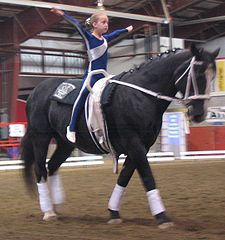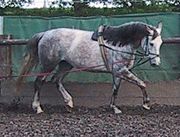
Side reins
Encyclopedia

Longeing
Longeing or lungeing is a technique for training horses, where a horse is asked to work at the end of a long line and respond to commands from a handler on the ground who holds the line. It is also a critical component of the sport of equestrian vaulting...
a horse, running from the bit
Bit (horse)
A bit is a type of horse tack used in equestrian activities, usually made of metal or a synthetic material, and is placed in the mouth of a horse or other equid and assists a rider in communicating with the animal. It rests on the bars of the mouth in an interdental region where there are no teeth...
of the bridle
Bridle
A bridle is a piece of equipment used to direct a horse. As defined in the Oxford English Dictionary, the "bridle" includes both the headstall that holds a bit that goes in the mouth of a horse, and the reins that are attached to the bit....
to the saddle
Saddle
A saddle is a supportive structure for a rider or other load, fastened to an animal's back by a girth. The most common type is the equestrian saddle designed for a horse, but specialized saddles have been created for camels and other creatures...
or surcingle
Surcingle
A surcingle is a strap made of leather or leather-like synthetic materials such as nylon or neoprene, sometimes with elastic, that fastens around a horse's girth area. A surcingle may be used for ground training, some types of in-hand exhibition, and over a saddle or horse pack to stabilize the load...
. As a horse training
Horse training
Horse training refers to a variety of practices that teach horses to perform certain behaviors when asked to do so by humans. Horses are trained to be manageable by humans for everyday care as well as for equestrian activities from horse racing to therapeutic horseback riding for people with...
tool, they encourage flexion and softness in the horse's mouth. For longe
Longe
Longe it was the third album of the Portuguese band Pólo Norte. It was published in 1999 and its producer was Jony Galvão. The great hits were: Vou p´ra Longe e Como uma onda.-Track listing:* 1. Vou p'ra Longe* 2. O Céu Pode Esperar...
work with a rider up who does not carry ordinary riding rein
Rein
Reins are items of horse tack, used to direct a horse or other animal used for riding or driving. Reins can be made of leather, nylon, metal, or other materials, and attach to a bridle via either its bit or its noseband.-Use for riding:...
s, they help calm and settle the animal. However, they are a tool best used by experienced handlers; used improperly they may unduly restrict the horse's movement or cause an accident.
The Side Rein
Side reins are made of leather or webbing, sometimes with added elastic, and have several rings or holes for buckles along their length. They are easily adjusted. Some designs have adjustable buckles and attach to the bit with a snap, other designs run through the bit ringBit ring
The bit ring is the ring on the side of a horse's bit, particularly on a snaffle bit. It is used as a point of attachment for the cheekpieces of the bridle and for the reins. It also has an effect on the action of the bit...
, then fold back on themselves and snap to their own rings.
Side reins may be completely of solid material, or they may have an elastic or rubber ring insert. Each design has its advantages and disadvantages. Designs with elastic have more "give" to them, which is useful for sensitive horses or horses that throw their heads. Elastic inserts must be used with caution, however, as some horses learn to lean on them. Solid side reins are the older, classical design, give the horse a more solid contact to work into and discourage leaning, but must be adjusted with greater care because their lack of give may upset a sensitive horse and, particularly if too tight, may provoke rearing, headshaking
Headshaking
Headshaking is a condition where the horse or pony shakes its head continuously, often while being ridden.Originally considered a bad habit, it is now thought that some horses are allergic to certain pollens, which causes them to headshake. However horses also normally react to flies, and...
and even panic in some animals. Side reins with a rubber donut provide some give, although not as muct as elastic and so discourage leaning. However, they are heavier and are prone to bounce when the horse trots or canters, which does not provide as steady a contact as the solid or elastic-insert side reins.
Uses of the Side Rein
Elasticized side reins are often used with trainingHorse training
Horse training refers to a variety of practices that teach horses to perform certain behaviors when asked to do so by humans. Horses are trained to be manageable by humans for everyday care as well as for equestrian activities from horse racing to therapeutic horseback riding for people with...
young horses prior to being ridden. They help accustom a horse to the feel of pressure on the bit, and reward the horse when it gives or flexes to bit pressure. Solid side reins are usually used for more advanced horses. They give the horse something to take contact with, encourage balance and correct head carriage, help a horse develop self-carriage, and help stop a horse from over-bending in the neck.
Adjustment of the Side Rein
Side reins may be attached from the bit rings to the surcingleSurcingle
A surcingle is a strap made of leather or leather-like synthetic materials such as nylon or neoprene, sometimes with elastic, that fastens around a horse's girth area. A surcingle may be used for ground training, some types of in-hand exhibition, and over a saddle or horse pack to stabilize the load...
rings, or from the bit to the buckles of the girth
Girth (tack)
A girth, sometimes called a cinch , is a piece of equipment used to keep the saddle in place on a horse or other animal. It passes under the barrel of the equine, usually attached to the saddle on both sides by two or three leather straps called billets...
of an English saddle
English saddle
English saddles are used to ride horses in English riding disciplines throughout the world. The discipline is not limited to England or English-speaking countries. This style of saddle is used in all of the Olympic and FEI equestrian disciplines, except for the newly-approved FEI events of...
or cinch rings of a western saddle
Western saddle
Western saddles are used for western riding and are the saddles used on working horses on cattle ranches throughout the United States, particularly in the west. They are the "cowboy" saddles familiar to movie viewers, rodeo fans, and those who have gone on trail rides at guest ranches...
.
Side reins are adjusted longer for less-experienced horses, and gradually shortened and raised higher (from point of shoulder up to the point of hip) as a horse becomes better trained. Side reins should never be so short that the horse's head is pulled behind the vertical. For green horses, the side reins should be adjusted so that the horse's head is approximately 4 inches in front of the vertical and the side reins are attached at a point level with the point of the shoulder.
As the horse becomes more advanced and more physically developed, the side reins may be shortened so the head is nearly vertical to the ground. Side reins should not pull the horse in—they do NOT create collection. Rather, a properly longed horse will collect himself, and the shorter side reins will be the correct length for him to keep a contact with the bit. Short side reins should not be used for long periods of time.
Side reins should usually be adjusted so they are the same length on each side, though in some cases, the inside rein may be slightly shorter, particularly with a horse that has previously been allowed to develop the habit of arcing its body away from the circle. It is considered correct to fasten the outside rein before the inside rein, similarly to the idea that a rider would take up outside contact before inside rein contact. It is best to make sure that both side reins are adjusted before attaching them to the bit, as it can be irritating to the horse to stand with one side rein attached while the handler is adjusting the other.
Improper adjustment of side reins can cause a horse to go behind the bit, spoil the horse's training, and even cause the horse to feel trapped, leading to rearing
Rear (horse)
Rearing occurs when a horse or other equid "stands up" on its hind legs with the forelegs off the ground. Rearing may be linked to fright, aggression, excitement, disobedience, or pain. It is not uncommon to see stallions rearing in the wild when they fight, while striking at their opponent with...
and the possibility that the horse will flip over.
When to Attach Side Reins
A horse should always be warmed up and cooled down without the side reins, allowed to stretch long and low. When the side reins are first applied during a workout, they should be adjusted long and gradually shortened as the horse warms up into them.Side reins are only for work in the trot and canter. Working a horse in side reins at the walk, other than in brief transitions can spoil the gait by inhibiting forward motion.
Side reins should not be used for jumping, as they restrict the use of the neck too much, and may even cause the horse to fall.
The Sliding Side Rein/Lauffer Rein

Like the side rein, the lauffer rein is adjusted so that the horse has contact with it when his head is at or just in front of the vertical. Green horses should have the lauffer rein attached to a lower and middle surcingle rein, while more advanced horses can have the reins raised to a middle and high ring on the surcingle.
The sliding side rein was designed to be attached to the outside rings of the surcingle, not between the legs. Running the reins between the legs can encourage a horse to get behind the bit and overflex.

